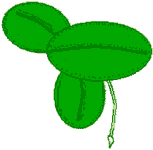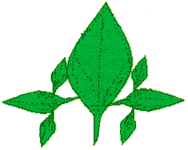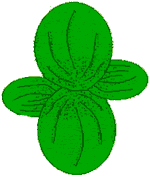The family Lemnaceae is divided into two subfamilies on basis of the
structure of the thallus (frond), the position of the inflorescence, and
presence or absence of a scale:

| Strictly the Lemnaceae, most primitive
(Lemoideae) |
|
|

| Woffiella, those more advanced
(Wolffioideae) |
|
Lemna forms:
|
Lemna aequinoctialis
Lemna gibba
Lemna minor
Lemna minuta
Lemna trisulca
Lemna turionifera
Lemna valdivana
|
|
|
Spirodela forms:
|
Spirodela polyrrhiza
Spirodela punctata
|
|
Wolffia forms:
|
Wolffia arrhiza
Wolffia borealis
Wolffia brasiliensis
Wolffia columbiana
Wolffia globosa
|
|
|
Wolffiella forms:
|
Wolffiella lingulata
Wolffiella oblonga
|
|
Subfamily Lemnaceae is characterized:
-
by the presence of one root or beam of several roots,
-
by two lateral pockets on the fronds,
-
by the single inflorescence, included within the thin scale covering, consisting
of two male and one female flower.
The representatives of the subfamily of Wolffiella have
these special features:
-
they lack roots,
-
they have one basal pocket,
-
they have one (or less frequently two) flowering pits on the dorsal surface,
situated to the right and to the left of the center line of the frond,
-
they have a single inflorescence (less frequently 2), consisting of one
female and one male flower, without a scale covering.
In the subfamily of the Lemnaceae there are two kinds: common duckweed
(Lemna, 9 or more almost cosmopolitan forms) and greater duckweed
(Spirodela, 4 forms, widespread in moderate and tropical belts/zones
both hemispheres). Strictly the Lemnaceae - largest plants, are easily
seen by the naked eye. They are green and resemble a floating sheet.
Greater duckweed always floats on the surface of water. Its flat/planar,
egg-shaped or elongated, sometimes reniform, frond bears daughter fronds
on both sides and (viewed from below) are frequently red or reddish-violet
because of the presence of the pigmented cells. Fronds of Spirodela
have a length of 3 - 10 mm and a width of 1.2 - 8 mm. On the lower
surface there are always one or more roots, whose length depends on the
depth of the water and whose length variesin the range of 1 - 10 cm.
Ivy-leaf duckweed forms long, sometimes branching, spiral-shaped chains/networks
from 3 - 22, and sometimes also to 50 fronds. Falling into the depth
of the reservoir, where it is little light, this chain/network of duckweed
fronds can be rounded, elliptical, oblong, elongated or lancate.
Their sizes/dimensions are very small.
Two small duckweeds, Lemna perpusilla (from the eastern part
of North America) and Lemna minuscula (from North and South America),
both measure 1 - 2.5 mm in length, and 0.7 - 2 and 0.7 - 1.5 mm in width
respectively. The length of the largest form - ivy-leaf duckweed
- on the long axis measures 5 - 20 mm, and in width 2.5 - 5 mm.
Most duckweed fronds are symmetrical and flat/planar. Only swollen
duckweed (Lemna gibba), which grows in Western Europe and South
America, and Lemna disperma, from South Australia and New Zealand
have an apparent convexity on the lower side, filled with aeriferous cavities,
distinctly visible in the transverse sections (A.L.Takhtadzhyan, 1982).
The forms of Wolffia, in contrast to the rest, possess a volumetric
and thick, sometimes sealed on the dorsal side, frond of globular, oval
or egg-shaped form. They always sail on the surface of the water.
Wolffia are the smallest flowering plant in the world, and rarely
exceed 1 mm in length or width. In our latitudes there is a rootless
Wolffia, (Wolffia arrhiza). To the naked eye this tiny
plant is difficult to view; but its colonies are easily noticed and resemble
the spots of coffee on the water because of a brown pigment that is contained
in the cells of epidermis. The presence of this pigment is characteristic
for all Wolffioideae, whereas druses are not formed in them.
The sizes/dimensions and forms of fronds of Wolffioideae to a considerable
degree depend on the season. In California, for example, fronds of
Wolffiella
of oval form have maximum sizes and greatest variety of forms in the winter
months.
Those blooming the plant of Wolffioideae are encountered sufficiently
rarely and for a long time scientists considered that Wolffioideae had
lost the ability to flower. Only in 1935 did scientists identify
flowering in Wolffia oblonga found growing in Argentina.
Under unfavorable conditions, including the cold of winter, Wolffioideae
turions survive by sinking to the bottom. These turions are similar,
for example in Wolffia, to the form and the sizes/dimensions of
normal fronds, but are heavier because of they are filled with starch.
Brief characteristics of the forms encountered in the Kuban
area:
 |
Lesser
duckweed (Lemna minor L.) - plant floating on the water.
Size/dimension of fronds 2-4 mm. the number of veins - 3. Frond flat/planar,
forming groups of 3 - 6 plants. It is encountered in standing water.
In the lowlands and in the foothills. Food for the birds. |
 |
Swollen
duckweed (Lemna gibba L.) - the lower side of fronds is strongly
convex, grows to 7 mm in length. Green or reddish. Number of
veins 3 sometimes 5. They are arranged/located with single plants
or groups of 2 - 5 fronds. |
 |
Ivy-leaf
duckweed (Lemna trisulca L.) Plant immersed in the water.
Stems in the form of oblong- lancate plates, 6 - 10 mm, the number of veins
- 3. Frequently the plants remain connected in groups of 8 - 30 fronds. |
 |
Greater
duckweed (Spirodella polyrrhiza (L.) Schleid. Fronds
in the form of rounded plates from 6 to 10 mm in length, that float on
the water, from below reddish. Veins from 7 to 12. Colonies from
2 to 5 plants are formed. It is encountered in estuaries, quiet creeks
and the ponds. In the valley of Kubans. Food plant for birds. |
 |
Water
meal (Wolffia arrhiza (L.) Wimm. - plant floating.
Stems globular- are oval, about 1 mm of long, single or paired. Veins
are absent. It is encountered in standing water. Food for birds
(I.S.Kosenko, 1970). |
|